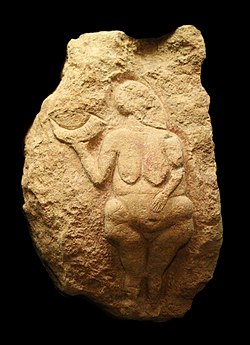| Venus of Laussel | |
|---|---|
 Tablet on display in the British Museum | |
| Material | Limestone |
| Size | Height: 46 cm |
| Created | c. 23,000 BC |
| Discovered | 1911 Marquay, Dordogne, France |
| Discovered by | Jean-Gaston Lalanne |
| Present location | Musée d'Aquitaine, Bordeaux, France |
The Venus of Laussel is an 18.11-inch-high (46.0-centimetre) limestone bas-relief of a nude woman. It is painted with red ochre and was carved into the limestone of a rock shelter (Abri de Laussel) in the commune of Marquay, in the Dordogne department of south-western France. The carving is associated with the Gravettian Upper Paleolithic culture (approximately 25,000 years old). It is currently displayed in the Musée d'Aquitaine in Bordeaux, France.
Contents


